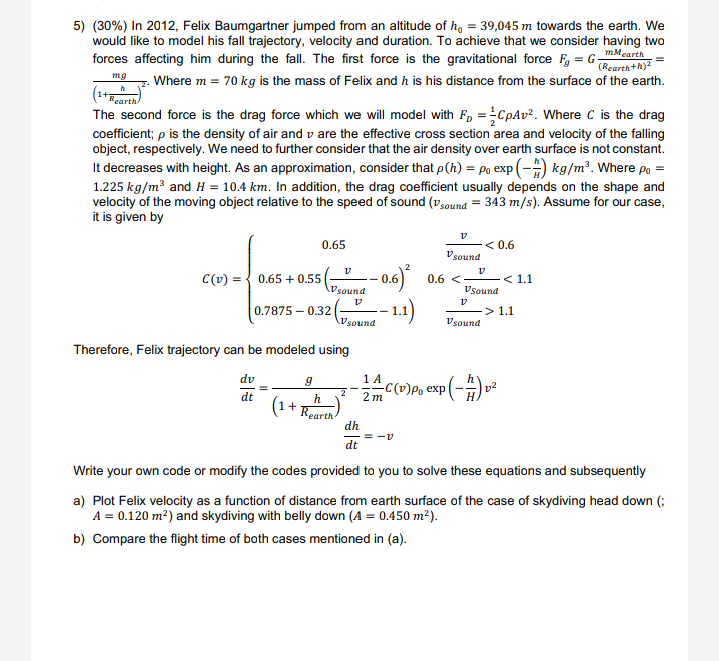Please please solve it , I really need the answer The submission date is roughly end , please solve it. I will directly click thumps up and I will say to my friends to click thumps up.
If u want, u can edit on the code below according to What question need . If not , u can write ur own code
#include
#include
int main()
{
FILE *ptr1,*ptr2,*ptr3; int
m=70,vs=343,Re=6378000,t; double
A=0.120,p0=1.225,H=10.4*pow(10,3),delt=0.1,g=9.8,cv=0;
double v[10000],h[10000];
v[0]=0,h[0]=39045;
ptr1=fopen("D:\\cprogram\\T.txt", "w");
ptr2=fopen("D:\\cprogram\\V.txt", "w");
ptr3=fopen("D:\\cprogram\\P.txt", "w");
for(t=0;t
{
if(v[t]/vs
{
cv=0.65;
}
else if(0.6 {
cv=0.65+0.55*(v[t]/vs-0.6)*(v[t]/vs-0.6);
}
else if(v[t]/vs>1.1)
{
cv=0.7875-0.32*(v[t]/vs-1.1);
}
v[t+1]=v[t]+ (g/pow(1+h[t]/Re,2)-1/2*cv*p0*exp(-h[t]/H)*v[t]*v[t])*delt;
h[t+1]=h[t]-v[t]*delt; if(h[t]
fprintf(ptr1,"%d ",t);
fprintf(ptr2,"%f ",v[t]);
fprintf(ptr3,"%f ",h[t]);
printf("%f",v[t]);
printf(" %f ",h[t]);
}
fclose(ptr1) ;
fclose(ptr2) ;
fclose(ptr3) ;
return 0;
}

5) (30%) In 2012, Felix Baumgartner jumped from an altitude of h, = 39,045 m towards the earth. We would like to model his fall trajectory, velocity and duration. To achieve that we consider having two mMearth forces affecting him during the fall. The first force is the gravitational force Fg = G7 (Rearth+R) mg Where m= 70 kg is the mass of Felix and h is his distance from the surface of the earth. Rearth The second force is the drag force which we will model with Fo = CpAv? Where C is the drag coefficient; p is the density of air and v are the effective cross section area and velocity of the falling object, respectively. We need to further consider that the air density over earth surface is not constant. It decreases with height. As an approximation, consider that p(h) = pq exp(-) kg/m. Where pe = 1.225 kg/m3 and H = 10.4 km. In addition, the drag coefficient usually depends on the shape and velocity of the moving object relative to the speed of sound (vsound = 343 m/s). Assume for our case, it is given by V 0.65 1.1 V sound V sound Therefore, Felix trajectory can be modeled using dv g 1A -C(v) po exp () v2 dt 2 h 2 m (1+ Rearth dh =-V dt Write your own code or modify the codes provided to you to solve these equations and subsequently a) Plot Felix velocity as a function of distance from earth surface of the case of skydiving head down (; A = 0.120 m2) and skydiving with belly down (A = 0.450 m2). b) Compare the flight time of both cases mentioned in (a). 5) (30%) In 2012, Felix Baumgartner jumped from an altitude of h, = 39,045 m towards the earth. We would like to model his fall trajectory, velocity and duration. To achieve that we consider having two mMearth forces affecting him during the fall. The first force is the gravitational force Fg = G7 (Rearth+R) mg Where m= 70 kg is the mass of Felix and h is his distance from the surface of the earth. Rearth The second force is the drag force which we will model with Fo = CpAv? Where C is the drag coefficient; p is the density of air and v are the effective cross section area and velocity of the falling object, respectively. We need to further consider that the air density over earth surface is not constant. It decreases with height. As an approximation, consider that p(h) = pq exp(-) kg/m. Where pe = 1.225 kg/m3 and H = 10.4 km. In addition, the drag coefficient usually depends on the shape and velocity of the moving object relative to the speed of sound (vsound = 343 m/s). Assume for our case, it is given by V 0.65 1.1 V sound V sound Therefore, Felix trajectory can be modeled using dv g 1A -C(v) po exp () v2 dt 2 h 2 m (1+ Rearth dh =-V dt Write your own code or modify the codes provided to you to solve these equations and subsequently a) Plot Felix velocity as a function of distance from earth surface of the case of skydiving head down (; A = 0.120 m2) and skydiving with belly down (A = 0.450 m2). b) Compare the flight time of both cases mentioned in (a)







